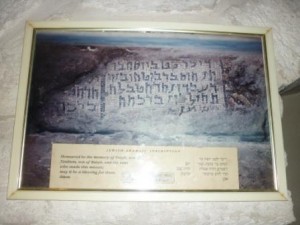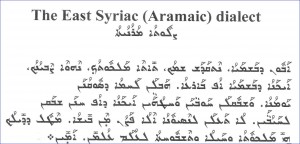Answer
Salam Dear Aini,
Thank you for your questions and for contacting Ask About Islam.
The language of Jesus was Aramaic, which was the common language of Galilee during his lifetime. Aramaic is a member of the Semitic branch of the Afro-Asiatic language family, and it has a 3,000-year history.
It was spoken by the Aramaeans, an ancient Middle Eastern semi-nomadic people who lived in upper Mesopotamia, an area that is currently parts of Iraq, eastern Syria, and southeastern Turkey. It was closely related to Hebrew, Phoenician and Syriac.
According to the historians of language, Aramaic first appeared among the Aramaeans in the 11th century BC. By the 7th and 6th centuries BC, it evolved into the lingua franca among the people of the Middle East.
In the 6th century BC, Aramaic replaced Hebrew as the language of the Children of Israel, particularly in Syria and Palestine. Certain portions of the Old Testament (specifically the books of Daniel and Ezra) were written in Aramaic, as were the Babylonian and Jerusalem versions of the Talmud (a collection of the Jewish law as well as its explanations by Jewish scholars of the past).
The history of Aramaic is usually broken into three major periods:
- Old Aramaic (1100 BC–AD 200) which includes the Biblical Aramaic of the Hebrew Bible and the Aramaic of Jesus
- Middle Aramaic (AD 200–1200) which includes Literary Syriac and the Aramaic of the Talmuds
- Modern or Neo-Aramaic (AD 1200–present) which includes various modern spoken varieties
In the early centuries after Christ, Aramaic split into Eastern and Western varieties. Eastern Aramaic has a number of surviving varieties with no mutual intelligibility among those spoken by Christians, Jews, and Mandaeans. Western Aramaic survives today only in the mountains of Syria, along the Lebanese border.
Ironically, the Biblical narrations of the words and deeds of Jesus called the Gospels were not originally written in Aramaic, which was Jesus’s own mother tongue, but were written in Greek, a Western language not related to the Eastern Semitic family of languages.
It is significant that we see clear indications in the Greek Gospels themselves of the fact that the language of Jesus was none other than Aramaic. There are situations in the Gospel stories where the original words of Jesus are given in his native tongue of Aramaic, even in the Greek Gospels as well as in some modern translations.
- In the Gospel of Mark, we see how a girl who was supposed to have been dead owing to serious illness was made whole by Jesus. Here is an account of what happened according to Mark:
He took her by the hand and said to her, “Talitha koum!” (which means, “Little girl, I say to you, get up!”). Immediately the girl stood up and walked around (she was twelve years old). At this they were completely astonished. (Mark 5: 41-42) (New International Version)
Talitha koum is an Aramaic expression meaning “Little girl, arise!”
- We read in the Gospel of Mark how Jesus opened the deaf ears of a man, by shouting “Ephatha”:
He looked up to heaven and with a deep sigh said to him, “Ephphatha!” (which means, “Be opened!” ). At this, the man’s ears were opened, his tongue was loosened and he began to speak plainly. (Mark 7:34-35) (New International Version)
Ephathaha is an Aramaic word meaning “be opened.”
These passages and others from the Gospels, combined with the evidence from contemporary historical sources, make it virtually certain that the language of Jesus was Aramaic.
Aramaic remained a dominant language for Jewish worship, scholarship, and everyday life for centuries in both the land of Israel and in the Diaspora, especially in Babylon.
Some of the Dead Sea Scrolls, the remains of the library of the Essene sect of Jews from around the first century CE, are in Aramaic. These new texts also provide the best evidence for Palestinian Aramaic of the sort used by Jesus and his disciples.
One may wonder then, why the Gospels were written in the Western language of Greek. The answer to this question is closely linked to the subversion of Jesus’s true religion by Saul of Tarsus, who became the self-styled “Apostle to the Gentiles” popularly known as St. Paul.
Just as the Jews translated many of the Hebrew scriptures (Old Testament books) into Aramaic, the early Christians also rendered their Gospels into Aramaic because it was the predominant language. Likewise the Greek gospels are now translated into English (and other languages) out of necessity.
Today, there are people who use Aramaic as their mother tongue in Iraq and Syria. These people belong to the Syrian Orthodox Church, which claims between 1 and 2 million people worldwide — many of them living in the West.
Recently the film The Passion of the Christ by Mel Gibson used the Aramaic language as the language of Jesus and his contemporaries, with English subtitles for the benefit of English-speaking audiences. The National Public Radio (NPR) of the United States has also of late presented programs on the history of Aramaic and its use at the time of Christ.
From the foregoing it is clear that the mother tongue of Jesus was Aramaic; and for this reason, obviously, Allah must have revealed the original Injeel in that language. And by Injeel, we do not mean any of the Gospels supposed to have been written by some of Jesus’s disciples.
The Injeel is the original Book of Allah revealed to Jesus in a language he and his people spoke — namely Aramaic. Even in the present Gospels, we find references to the Injeel as the Gospel of the Kingdom:
Jesus came into Galilee, preaching the Gospel of the Kingdom of God, and saying, “The time is fulfilled, and the Kingdom of God is at hand: repent ye, and believe the Gospel.” (Mark 1:14-15) (King James Version)
It is clear from the above that Jesus was not preaching one of the Gospels written by his disciples long after his earthly life had ended. And it is unreasonable to believe that any one of the four canonized Gospels written in Greek after Jesus’s time was the same as the Gospel of the Kingdom of God he preached.
The point we need to stress here is that the original Gospel of the Kingdom of God mentioned by Jesus must have been the true Injeel revealed to Jesus by God, and its language must have been Aramaic.
Now about English being a “Christian” language: Born and living in the East, Jesus had little opportunity (nor had he the need) to learn any Western language, and of course English didn’t exist so he didn’t use it.
Many Christians of the present day use the English language because they hail from English-speaking lands and not because English is a Christian language. Christians, like anyone else, can speak other languages such as French, Spanish, German, Chinese, and Arabic, and they read the Bible in their own language.
I hope this answers your questions. Please stay in touch.
Salam.
